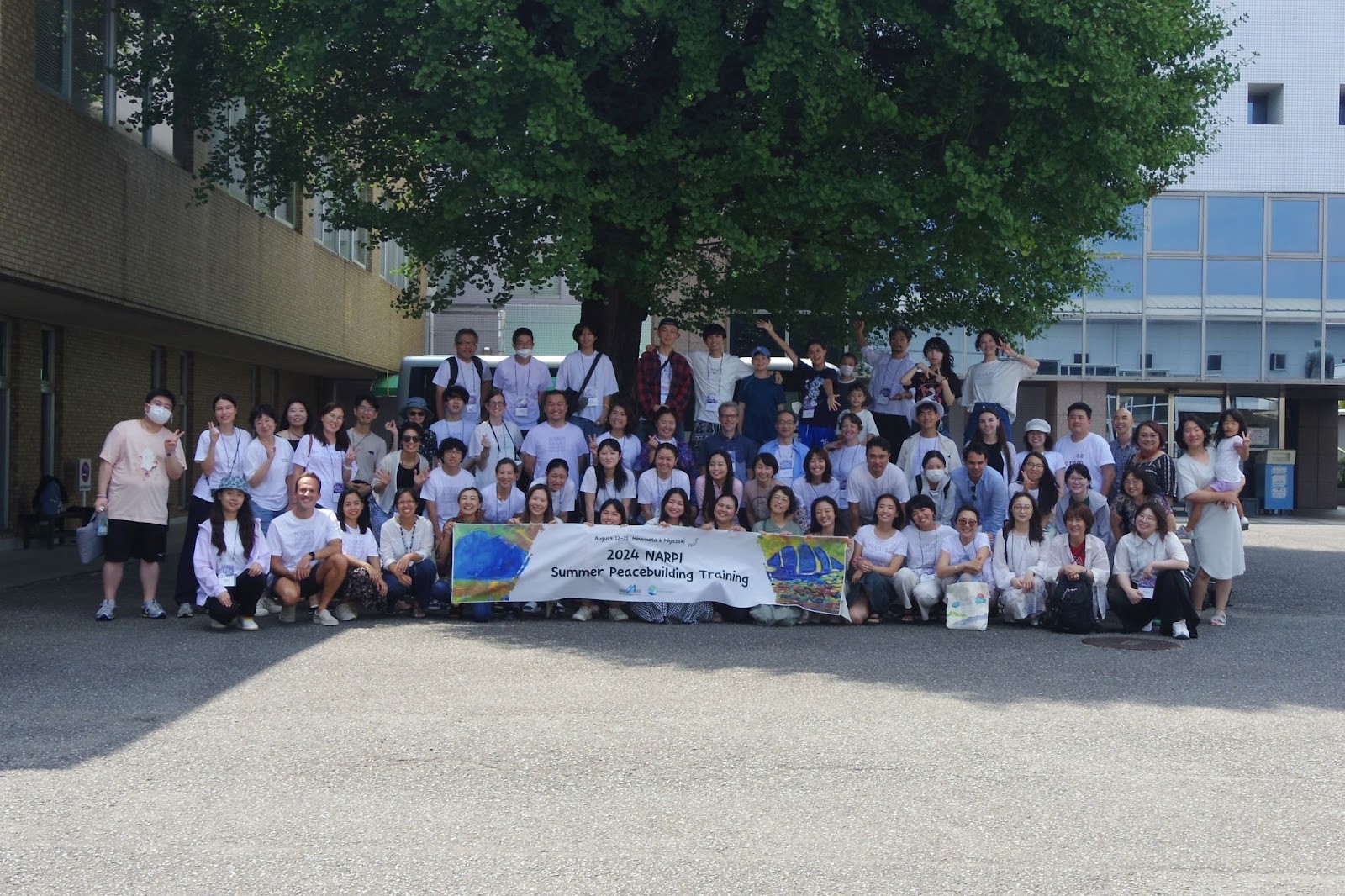A Transformative Journey
Peacebuilding in Northeast Asia
By Jocelyn Wright
In the week leading up to the 2024 Northeast Asia Regional Peacebuilding Institute (NARPI) Summer Peacebuilding Training in Minamata and Miyazaki, Japan, news broke of a “megaquake.” The consequential safety concerns were the first unexpected challenge for the institute’s steering committee, local hosts, and admin to successfully navigate. Other issues on the ground included difficulties finding taxis in rural areas, a jellyfish sting, COVID-19 cases, and the need to subsequently rearrange accommodations and modify instruction. Still, NARPI organizers, course facilitators, and participants transcended all of these sorrows and conflicts peacefully together as they conducted their annual summer institute in two prefectures of Kyushu from August 12 to 20. As a grateful participant, I wish to relate what we did as a group.
On registration day, NARPI did not host any events, but partner organizations, Global Partnership for the Prevention of Armed Conflict (GPPAC) and the American Friends Service Committee (AFSC), ran an afternoon of peace games facilitated by Cheryl Woelk, who is also based in Korea. The experiential peace games were an opportunity to simulate multi-track United Nations negotiations and brought to the table 33 participants from various peacebuilding fields (the arts, education, humanities, and social and natural sciences) and countries to discuss regional issues related to women, peace, and security in Japan, North and South Korea, Mongolia, Mainland China, and Taiwan. As per design, the agenda was reached through consensus. Although the situation was intense and complex and some of the results were unanticipated, the peaceful process was satisfying and hopeful.
The next morning, NARPI began softly with a two-day field trip in Minamata led by Akiko Ishihara of Kumamoto University. Minamata is infamous for an industrial disaster caused to the small fishing village on the west coast by a Chisso Corporation factory from the 1950s with devastating social, economic, and environmental consequences still felt today although ongoing efforts to seek restorative justice and transform the area into an eco-village have also been underway for several decades.
On the field trip, 84 participants, facilitators, administrators, hosts, and volunteers spanning generations had a chance to visit ground zero (the Hyakken Drainage Outlet that dumped methylmercury-contaminated wastewater into the bay), the eco-park, the Minamata Memorial, and the fascinating Soshisha Minamata Disease Museum. We also heard impactful stories from the diverse perspectives of victim leaders of Minamata disease, including a fetal patient of the disease, and a city government official who was involved in community revitalization and restoration projects. These really set the tone!
Because of the integration of art and culture, participants also got to try making onigiri rice balls for breakfast, preparing tea, printing NARPI shirts, learning about kokeshi prayer dolls, partaking in Japanese folk dance, making traditional paper, crafting necklaces with local sea products, and experiencing a healing holistic-care technique called Tapping Touch (https://www.tappingtouch.org). Physical activities such as swimming and kayaking were options in the rich and varied program. Personally, I enjoyed watching others doing water sports as the sun set.
The final evening in Minamata, all were treated to a delicious and beautiful vegan feast with an international menu that everyone could enjoy, catered by local businesses. The highlight was an impressive mandala salad and a tea bar. This Peace Dinner was accompanied by participant performances. That night, there was the option to bathe in onsen (hot springs) at the mountain ryokan (traditional Japanese-style inn), where we shared rooms, stories, and individual habits (e.g., playing the ukulele) that made everyone closer.
The final destination was a small paradise on the east coast where participants engaged in a week of lectures and training at Miyazaki International University, coordinated by Aya Kasai. After arriving, we first carried out a precautionary evacuation drill, then enjoyed an evening of rest. With our impressive field trip fresh in mind, we began to explore the topical courses Conflict and Peace Framework, Optimizing Peacebuilding by Increasing Trauma Awareness, Exploring Gender and Sexuality in Conflict and Peacebuilding: An Arts-Based Approach, Restorative Justice: Healing Our Society and the Planet, and Creating Peacebuilding Programs.
Each English or mixed-medium course was small and cozy. Facilitated by at least two experienced NARPI facilitators, they employed a variety of pedagogies. The classes were interactive and experiential as a result, leading to stimulating reflection and exchanges. Local activists were also invited in for dialogic sessions, which kept us grounded. This was peace education in practice!
Over the week, we stayed with family and/or roommates in a hostel near the sea, ate meals together, and tasted snacks we brought from home. These kept us tight. Sadly, due to logistical difficulties accommodating COVID-19 patients and needing to find replacement training venues, our courses had to wrap up a day early. Nevertheless, the preventive measures kept everyone safe, and we left with fond memories of our caring NARPI family.
Customarily, there is also a Culture and Talent Show. Granted the exceptional circumstances, this year’s was smaller and held outdoors on the last day, but it was still a special occasion to share traditional dress, song, dance, and poetry. The complete program inspired me to write and recite the following:
The Power of NARPI
Strangers
United by common values and visions
Connecting, sharing, growing
Making memories together
Developing friendships and networks
Imagining possibilities, plans, and projects
Taking away more than
knowledge, skills, and resources
To use critically and creatively
in their work and life
To heal, restore,
strengthen, and more
As peacebuilders in and across relationships,
borders, and time
Such is the power of NARPI
Recorded in simple rhyme
I feel full of gratitude for NARPI and certainly hope to join again somewhere new! If you are interested in learning more about the institute, you can refer to their website (www.narpi.net).
The Author
Jocelyn Wright is an associate professor in the Department of English Language and Literature at Mokpo National University in South Korea. Her interests include matters at the heart of the intersecting fields of peace linguistics, peace (language) education, and peace literature.





